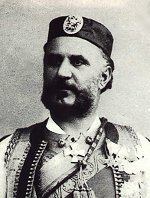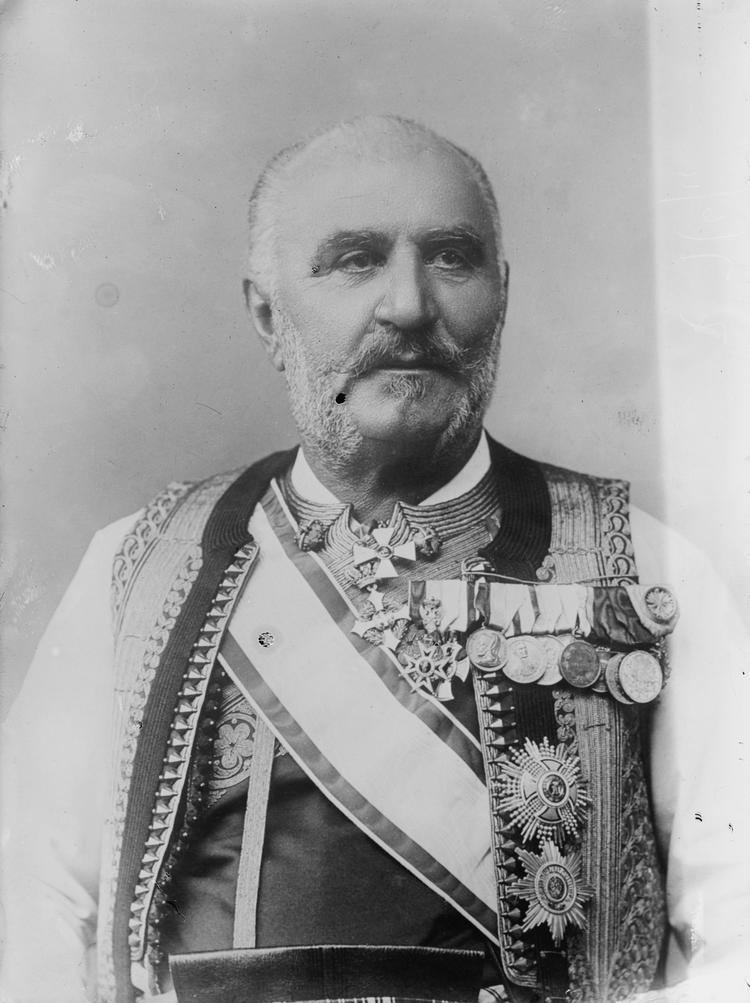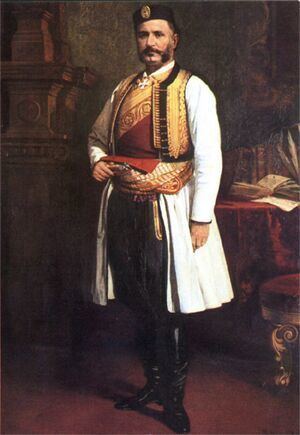Predecessor Danilo I Spouse Milena Vukotic (m. 1860) Role Ruler | Name Nikola Petrovic-Njegos Coronation 28 August 1910 House Petrovic-Njegos dynasty | |
 | ||
Reign 13 August 1860 – 28 August 1910 Reign 28 August 1910 – 26 November 1918 Born 7 October 1841
Njegusi, Montenegro ( 1841-10-07 ) Burial Cetinje, the Chapel of Cipur Issue
Detail Zorka, Princess of Serbia
Milica, Grand Duchess of Russia
Anastasia, Grand Duchess of Russia
Danilo, Crown Prince of Montenegro
Elena, Queen of Italy
Anna, Princess Francis Joseph of Battenberg
Prince Mirko
Princess Xenia
Prince Peter Died March 1, 1921, Antibes, France Children Elena of Montenegro, Princess Milica of Montenegro Parents Michael, Prince of Montenegro, Mirko Petrovic-Njegos Similar People Danilo I - Prince of Montenegro, Nicholas - Crown Prince of, Elena of Montenegro, Princess Milica of Montenegro, Princess Zorka of Montenegro | ||
Kralj Nikola I Petrović Njegoš
Nikola I Petrović-Njegoš (Serbian Cyrillic: Никола I Петровић-Његош; 7 October [O.S. 25 September] 1841 – 1 March 1921) was the ruler of Montenegro from 1860 to 1918, reigning as sovereign prince from 1860 to 1910 and as king from 1910 to 1918.
Contents
- Kralj Nikola I Petrovi Njego
- Early life
- Prince of Montenegro
- King of Montenegro
- Children
- In literature
- References
Early life

Nikola was born in the village of Njeguši, the ancient home of the reigning House of Petrović. His father, Mirko Petrović-Njegoš, a celebrated Montenegrin warrior, was elder brother to Danilo I of Montenegro, who left no male offspring. After 1696, when the dignity of Vladika, or prince-bishop, became hereditary in the Petrović family, the sovereign power had descended from uncle to nephew, the Vladikas belonging to the order of the black clergy (i.e., monastic clergy) who are forbidden to marry. A change was introduced by Danilo I, who declined the episcopal office, married and declared the principality hereditary in the direct male line. Mirko Petrović-Njegoš having renounced his claim to the throne, his son was nominated heir-presumptive, and the old system of succession was thus accidentally continued.

Prince Nikola, who had been trained from infancy in martial and athletic exercises, spent a portion of his early boyhood at Trieste in the household of the Kustic family, to which his aunt, the princess Darinka, wife of Danilo II, belonged. The princess was an ardent francophile, and at her suggestion the young heir-presumptive of the vladikas was sent to the Lycée Louis-le-Grand in Paris. Unlike his contemporary, King Milan of Serbia, Prince Nikola was little influenced in his tastes and habits by his Parisian education; the young highlander, whose keen patriotism, capability for leadership and poetic talents early displayed themselves, showed no inclination for the pleasures of the French capital, and eagerly looked forward to returning to his native land.

Nikola was a member of the "United Serbian Youth" (Уједињена омладина српска) during its existence (1866–1871). After the organization was prohibited in the Principality of Serbia and Austro-Hungary, the "Association for Serb Liberation and Unification" (Дружина за ослобођење и уједињење српско) was established by Nikola, Marko Popović, Simo Popović, Mašo Vrbica, Vasa Pelagić, and more, in Cetinje (1871).
Prince of Montenegro

Nikola was still in Paris when, in consequence of the assassination of his uncle Danilo I, he succeeded as prince (13 August 1860). In November 1860 he married Milena, daughter of the vojvoda Petar Vukotić.

In the period of peace which followed Nikola carried out a series of military, administrative and educational reforms. The country was embroiled in a series of wars with the Ottoman Empire between 1862 and 1878. In 1867 he met the emperor Napoleon III at Paris, and in 1868 he undertook a journey to Russia, where he received an affectionate welcome from the tsar, Alexander II. He afterwards visited the courts of Berlin and Vienna. His efforts to enlist the sympathies of the Russian imperial family produced important results for Montenegro; considerable subsidies were granted by the tsar and tsaritsa for educational and other purposes, and supplies of arms and ammunition were sent to Cetinje. In 1871 Prince Dolgorukov arrived at Montenegro on a special mission from the tsar, and distributed large sums of money among the people. In 1869 Prince Nikola, whose authority was now firmly established, succeeded in preventing the impetuous highlanders from aiding the Krivosians in their revolt against the Austrian government; similarly in 1897 he checked the martial excitement caused by the outbreak of the Greco-Turkish War.

In 1876 Nikola declared war against Turkey; his military reputation was enhanced by the ensuing campaign, and still more by that of 1877/78, during which he captured Nikšić, Bar and Ulcinj. The war resulted in a considerable extension of the Montenegrin frontier and the acquisition of a seaboard on the Adriatic. He justified the war as a revenge for the Battle of Kosovo (1389). In 1876 he sent a message to the Montenegrins in Herzegovina:
Under Murad I the Serbian Tsardom was destroyed, under Murad V it has to rise again. This is my wish and wish of all of us as well as the wish of almighty God.The independence of Montenegro was recognised at the Congress of Berlin in 1878 and in the succeeding decades Montenegro enjoyed considerable prosperity and stability. Education, communications and the army expanded greatly (the latter with support from Imperial Russia). In 1883 Prince Nikola visited the sultan, with whom he subsequently maintained the most cordial relations; in 1896 he celebrated the bicentenary of the Petrović dynasty, and in the same year he attended the coronation of the Tsar Nicholas II; in May 1898 he visited Queen Victoria at Windsor Castle.
King of Montenegro
In 1900 Nikola took the style of Royal Highness.
According to Bolati, the Montenegrin court was not grieving that much over the murder of King Alexander Obrenović, as they saw him as an enemy of Montenegro and obstacle to the unification of Serbdom. "Although it wasn't said openly, it was thought that the Petrović dynasty would achieve [the unification]. All procedures of King Nikola shows that he himself believed that".
He gave Montenegro its first constitution in 1905 following pressure from a population eager for more freedom. He also introduced west-European style press freedom and criminal law codes. In 1906, he introduced Montenegrin currency, the perper. On 28 August 1910, during the celebration of his jubilee, he assumed the title of king, in accordance with a petition from the Skupština. He was at the same time gazetted field-marshal in the Russian army, an honor never previously conferred on any foreigner except the Duke of Wellington. When the Balkan Wars broke out in 1912 King Nikola was one of the most enthusiastic of the allies. He wanted to drive the Ottomans completely out of Europe. He defied the Powers and captured Scutari despite the fact that they blockaded the whole coast of Montenegro. Again in the Great War which began in 1914 he was the first to go to Serbia's aid to repel the Austrian forces from the Balkan Peninsula. He was personally a huge supporter of Serbdom, and wished for Serb unity. However, he was bitterly opposed to the Karađorđevićs.
In January 1916, after the defeat of Serbia, Montenegro was also conquered by Austria-Hungary, and the King fled to Italy and then to France. The government transferred its operations to Bordeaux.
After the end of the First World War, a Serb-dominated meeting in Podgorica voted to depose Nikola and annex Montenegro to Serbia. A few months later, Serbia (including Montenegro) merged with the former South Slav territories of Austria-Hungary to form the Kingdom of Serbs, Croats and Slovenes, which was renamed Yugoslavia in 1929. Nikola went into exile in France in 1918, but continued to claim the throne until his death in Antibes three years later. He was buried in Italy. In 1989, the remains of Nikola, his queen Milena, and two of their twelve children were re-buried in Montenegro.
Children
Five of his daughters were married, each to princes and kings, giving Nikola the nickname "the father-in-law of Europe", a sobriquet he shared with the contemporary King of Denmark.
The present pretender to the throne is King Nikolas's great-grandson Prince Nikola, Prince Michael's son.
In literature
King Nikola and the Kingdom of Montenegro are remembered briefly in F. Scott Fitzgerald's The Great Gatsby, where its eponymous main character reminisces on how for his accomplishments and heroic endeavors during the First World War the King confers unto him the highest honor of the Kingdom the Orderi di Danilo. Gatsby duly presents the medal for his guest to examine which reads on the legend Montenegro, Nicolas Rex and on its reverse: Major Jay Gatsby - For Valour Extraordinary.
The character of the King in Maurice Chevalier's movie The Merry Widow (1934) is based on Nicholas.
